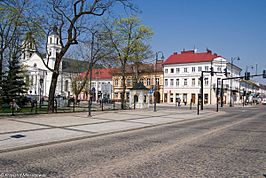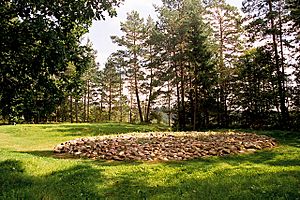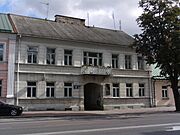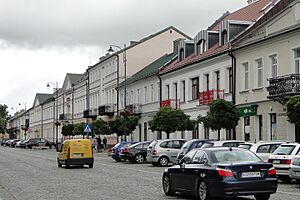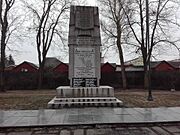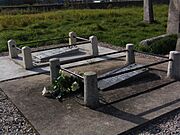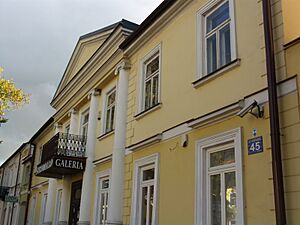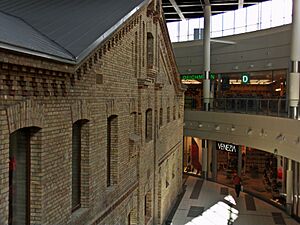Suwałki facts for kids
Quick facts for kids
Suwałki
|
|||
|---|---|---|---|
|
|||
|
|||
| Country | |||
| Voivodeship | Podlaskie | ||
| County | city county | ||
| Established | 1690 | ||
| City rights | 1720 | ||
| Area | |||
| • Total | 65.24 km2 (25.19 sq mi) | ||
| Elevation | 170 m (560 ft) | ||
| Population
(31 December 2021)
|
|||
| • Total | 69,206 |
||
| Time zone | UTC+1 (CET) | ||
| • Summer (DST) | UTC+2 (CEST) | ||
| Postal code |
16-400 to 16-403
|
||
| Area code(s) | +48 87 | ||
| Car plates | BS | ||
| Website | http://www.um.suwalki.pl/ | ||
Suwałki is a city in northeastern Poland. About 69,206 people lived there in 2021. It is the main city of Suwałki County. It is also an important place for business in the Podlaskie Voivodeship. Suwałki is the biggest city and the capital of the historical Suwałki Region.
The city is about 30 kilometers (19 miles) from the border with Lithuania. The Czarna Hańcza river flows through Suwałki. The area around Suwałki is known for the Suwałki Landscape Park, a protected natural area.
Contents
What's in a Name?
The name Suwałki comes from the Lithuanian language. It means "place near a small river or swampy area." This makes sense because of the local landscape.
Suwałki's History
The area where Suwałki is located was once home to ancient tribes. These included the Yotvingian and Prussian people. Later, the Teutonic Order took over these lands. For many centuries, the area was not very populated.
How Suwałki Started
In the 1600s, Camaldolese monks were given the land. This was in 1667 by the King of Poland, John II Casimir. The monks built their main center in Wigry. They built a monastery and a church there.
The monks started to use the forests for wood and other products. They brought many settlers to the area, mostly from Masovia. These settlers helped build new villages. The village of Suwałki was first mentioned in 1688. By 1690, it had only two houses.
Growing into a Town
Suwałki grew quickly. By 1700, it was split into two parts: Lesser and Greater Suwałki. The village was in the middle of the monks' lands. It was also on an important trade route. This route connected Grodno and Merkinė with Königsberg.
In 1710, King Augustus II the Strong allowed Suwałki to hold fairs and markets. Five years later, in 1715, it was given town rights. This meant it could grow and have its own rules. The town was planned with 300 lots for houses. People living there did not have to pay taxes for seven years.
On May 2, 1720, King August II approved the town rights. Suwałki could hold one fair each week and four markets a year. The town also got its own coat of arms. It showed Saint Roch and Saint Romuald.
Suwałki in the 1800s
After Poland was divided in 1795, Suwałki became part of Prussia. In 1796, the monastery in Wigry was closed. Its property was taken by the Prussian government. The next year, the local government moved to Suwałki. A military base also moved there. By the end of the 1700s, Suwałki had 1,184 people and 216 houses. Many Jewish people lived there.
In 1807, Suwałki became part of the Duchy of Warsaw. This was a new state created by Napoleon Bonaparte. After Napoleon's defeat, Suwałki became part of Congress Poland. This area was controlled by the Russian Empire. Suwałki became a capital again in 1816. It was the capital of the Augustów Voivodeship.
New buildings were constructed, including a new town hall. Streets were paved. The cemetery was moved outside the town. A town park was created. The Saint Petersburg–Warsaw Railway was built, which helped the town grow.
Between 1806 and 1827, Suwałki's population nearly tripled. It reached 3,753 people living in 357 houses. During the November Uprising in 1831, people in Suwałki fought against Russia.
In 1835, a police station was built. A new town hall and churches for different religions were finished in 1844. A new marketplace, a hospital, and a school were also opened. The main Catholic church was updated between 1840 and 1849. Many famous Polish architects worked on it. To make the town look more modern, building new wooden houses was banned in 1847.
The town's population kept growing fast. In 1857, it had 11,273 people. By 1872, it had almost 20,000. New factories needed workers. People from many different backgrounds came to live in Suwałki. It became the fourth-largest town in Congress Poland.
In 1866, the region's name changed to Suwałki Gubernia. However, a new railway line bypassed Suwałki. This slowed down its growth. In the early 1900s, a new Russian army base helped the economy. A railway line connecting Suwałki with Grodno was also finished.
The 1900s and Today
After 1905, Polish culture started to grow again. Even though Polish was not allowed in official use, new Polish schools opened. A Polish newspaper and a library also started.
When World War I began, there was heavy fighting in the area. In 1915, the Germans took control of Suwałki. The town was managed directly by the German army. Life was hard for people during this time. Secret groups formed to resist the Germans. In 1917, local branches of the Polish Military Organization were created.
After the war ended in 1918, the Germans agreed to let the region join Poland. But the German army stayed and continued to take resources. In February 1919, people in Suwałki voted in the first free Polish elections. However, the Germans changed their minds. They removed Polish soldiers and gave the area to Lithuanian control.
Independent Poland
By July 1919, the Paris Peace Conference decided Suwałki should be part of Poland. This led to fighting between Polish and Lithuanian forces. The war ended in mid-September. Talks happened in Suwałki in early October.
During the Polish-Bolshevik War, the Communists captured the town. After the Battle of Warsaw, it was given to the Lithuanians again. But the Polish Army soon took it back.
Between the two World Wars, Suwałki became an independent town within the Białystok Voivodeship (1919-1939). The town grew, with its population rising from 16,780 in 1921 to almost 25,000 in 1935. Trade and business became the main source of income. New water works and a power plant were built in 1931. Suwałki was also a large military base for Poland.
Suwałki During World War II

During the Polish Defensive War in 1939, the Red Army briefly captured Suwałki. On October 12, the Soviets left and gave the area to the Germans. This was part of the Molotov–Ribbentrop Pact. The city was renamed Sudauen and became part of Nazi Germany.
The Germans arrested many Poles in 1939 and 1940. These Poles were sent to camps or killed. People in Suwałki formed resistance groups. By 1942, the area had strong resistance networks. In the Szwajcaria area, there are burial sites for Polish resistance members. They were killed by the Germans on April 26, 1940, and April 1, 1944.
Sadly, almost all of the town's 7,000 Jewish residents were taken away and perished. The Germans also destroyed Jewish history and culture in the town. They tore down synagogues and damaged the Jewish cemetery. Today, a memorial stands there. In the Krzywólka area, the Germans set up a camp for about 120,000 Soviet prisoners of war.
On October 23, 1944, the Soviet army captured Suwałki. The fighting lasted several days. Almost 5,000 Soviet soldiers lost their lives. Former Polish resistance members continued to fight against the Soviets in the forests until the early 1950s.
Suwałki was not heavily damaged during World War II. Most historic buildings survived. The city was quickly rebuilt.
After the War
After the war, Suwałki remained a regional capital. However, the town recovered slowly. In 1975, a new administrative change made Suwałki the capital of its own Suwałki Voivodeship. The number of people living there grew fast. By the end of the 1970s, the population was over 36,000. Large factories were built, making Suwałki an important industrial and business center in Eastern Poland.
During the time of martial law in Poland in the early 1980s, the Solidarność movement was active. They asked for public buildings to be used for schools, kindergartens, and hospitals. They wanted a party building to be used for medical clinics and a youth center. The authorities did not agree at first.
After the end of Communist rule in 1989, Suwałki faced challenges. Many factories closed. But the creation of the Suwałki Special Economic Zone helped. Being close to the Russian and Lithuanian borders also created new chances for trade. The region also started to attract many tourists. Today, people from Suwałki often travel to Russia and Lithuania for shopping and attractions.
To military planners, the area between Lithuania and Poland is known as the Suwałki Gap. This is a narrow piece of land between Belarus and Russia's Kaliningrad. It is important because it connects the three NATO countries of the Baltic States to Poland and the rest of NATO.
People of Suwałki
Here's a look at the population of Suwałki over the years:
|
2002 – 68,923 people,
|
1931 – 21,826 people,
|
1921 – 16,780 people,
|
1897 – 22,648 people,
|
Suwałki's Climate
Suwałki has a changeable climate. It has a warm-summer humid continental climate. This means it has warm summers and cold winters. Compared to the rest of Poland, Suwałki's weather is more "continental." This means it's less affected by the ocean.
Suwałki has some of the biggest temperature changes in Poland. The coldest temperature ever was -35.5°C (-31.9°F) on January 12, 1950. The hottest was 37°C (98.6°F) on July 11, 1946. It also holds the record for the highest air pressure in Poland.
Weather changes often happen because of weather fronts. The growing season in Suwałki is the shortest in Poland. This means plants have less time to grow. Suwałki is often called the "Polish pole of cold." This is because it has the lowest average temperature of major cities in Poland. The actual coldest spot is about 25 km (16 mi) north, in Wiżajny.
Winters are cold, with lots of clouds and snow. Nights can be very cold, sometimes below -15°C (5°F). Temperatures below -25°C (-13°F) can also happen. Snow stays on the ground for the longest time here compared to other non-mountain areas in Poland.
Summers are nice, warm, and often sunny. Daily high temperatures can sometimes go above 30°C (86°F). However, summers in Suwałki are still a bit cooler than in other parts of Poland.
| Climate data for Suwałki (1991-2020 normals, 1951-present extremes) | |||||||||||||
|---|---|---|---|---|---|---|---|---|---|---|---|---|---|
| Month | Jan | Feb | Mar | Apr | May | Jun | Jul | Aug | Sep | Oct | Nov | Dec | Year |
| Record high °C (°F) | 11.9 (53.4) |
14.8 (58.6) |
20.4 (68.7) |
28.5 (83.3) |
30.9 (87.6) |
33.0 (91.4) |
35.3 (95.5) |
34.8 (94.6) |
33.3 (91.9) |
24.0 (75.2) |
15.7 (60.3) |
11.4 (52.5) |
35.3 (95.5) |
| Mean daily maximum °C (°F) | −1.0 (30.2) |
0.2 (32.4) |
4.9 (40.8) |
12.7 (54.9) |
18.4 (65.1) |
21.5 (70.7) |
23.8 (74.8) |
23.3 (73.9) |
17.7 (63.9) |
10.9 (51.6) |
4.5 (40.1) |
0.5 (32.9) |
11.5 (52.7) |
| Daily mean °C (°F) | −3.3 (26.1) |
−2.6 (27.3) |
0.9 (33.6) |
7.3 (45.1) |
12.6 (54.7) |
15.9 (60.6) |
18.1 (64.6) |
17.4 (63.3) |
12.5 (54.5) |
7.0 (44.6) |
2.3 (36.1) |
−1.6 (29.1) |
7.2 (45.0) |
| Mean daily minimum °C (°F) | −5.7 (21.7) |
−5.4 (22.3) |
−2.8 (27.0) |
2.0 (35.6) |
6.7 (44.1) |
10.3 (50.5) |
12.7 (54.9) |
11.9 (53.4) |
8.0 (46.4) |
3.7 (38.7) |
0.2 (32.4) |
−3.9 (25.0) |
3.1 (37.6) |
| Record low °C (°F) | −32.0 (−25.6) |
−32.0 (−25.6) |
−29.7 (−21.5) |
−10.0 (14.0) |
−4.6 (23.7) |
−0.9 (30.4) |
3.2 (37.8) |
0.9 (33.6) |
−4.3 (24.3) |
−14.2 (6.4) |
−20.7 (−5.3) |
−29.6 (−21.3) |
−32.0 (−25.6) |
| Average precipitation mm (inches) | 38.1 (1.50) |
31.5 (1.24) |
36.8 (1.45) |
34.8 (1.37) |
53.8 (2.12) |
66.9 (2.63) |
85.6 (3.37) |
70.9 (2.79) |
52.3 (2.06) |
52.4 (2.06) |
42.8 (1.69) |
41.0 (1.61) |
607.1 (23.90) |
| Average extreme snow depth cm (inches) | 11.9 (4.7) |
13.3 (5.2) |
10.3 (4.1) |
2.9 (1.1) |
0.3 (0.1) |
0.0 (0.0) |
0.0 (0.0) |
0.0 (0.0) |
0.0 (0.0) |
0.6 (0.2) |
2.7 (1.1) |
7.2 (2.8) |
13.3 (5.2) |
| Average precipitation days (≥ 0.1 mm) | 17.27 | 15.61 | 14.27 | 11.30 | 13.37 | 13.63 | 14.13 | 13.17 | 11.83 | 13.90 | 15.53 | 17.23 | 171.24 |
| Average snowy days (≥ 0,0 cm) | 20.7 | 19.8 | 11.7 | 1.7 | 0.1 | 0.0 | 0.0 | 0.0 | 0.0 | 0.8 | 5.5 | 15.6 | 75.9 |
| Average relative humidity (%) | 90.2 | 87.7 | 81.0 | 71.7 | 71.3 | 73.6 | 75.3 | 75.8 | 81.5 | 86.9 | 91.8 | 91.9 | 81.6 |
| Mean monthly sunshine hours | 35.8 | 54.2 | 119.9 | 182.2 | 249.7 | 252.4 | 252.3 | 233.3 | 155.3 | 90.8 | 29.7 | 23.3 | 1,678.9 |
| Source 1: Institute of Meteorology and Water Management | |||||||||||||
| Source 2: meteomodel.pl (humidity and extremes) | |||||||||||||
| Climate data for Suwałki (Szwajcaria), elevation: 184 m or 604 ft, 1961-1990 normals and extremes | |||||||||||||
|---|---|---|---|---|---|---|---|---|---|---|---|---|---|
| Month | Jan | Feb | Mar | Apr | May | Jun | Jul | Aug | Sep | Oct | Nov | Dec | Year |
| Record high °C (°F) | 8.3 (46.9) |
14.8 (58.6) |
20.4 (68.7) |
26.9 (80.4) |
30.3 (86.5) |
31.9 (89.4) |
34.5 (94.1) |
34.6 (94.3) |
29.7 (85.5) |
24.0 (75.2) |
15.7 (60.3) |
11.4 (52.5) |
34.6 (94.3) |
| Mean daily maximum °C (°F) | −2.9 (26.8) |
−1.7 (28.9) |
3.1 (37.6) |
10.5 (50.9) |
17.4 (63.3) |
20.4 (68.7) |
21.6 (70.9) |
21.4 (70.5) |
16.6 (61.9) |
10.6 (51.1) |
3.8 (38.8) |
−0.6 (30.9) |
10.0 (50.0) |
| Daily mean °C (°F) | −5.3 (22.5) |
−4.6 (23.7) |
−0.6 (30.9) |
5.6 (42.1) |
12.2 (54.0) |
15.4 (59.7) |
16.6 (61.9) |
16.0 (60.8) |
11.6 (52.9) |
6.8 (44.2) |
1.7 (35.1) |
−2.7 (27.1) |
6.1 (42.9) |
| Mean daily minimum °C (°F) | −8.2 (17.2) |
−7.7 (18.1) |
−4.0 (24.8) |
1.4 (34.5) |
6.7 (44.1) |
10.0 (50.0) |
11.4 (52.5) |
10.9 (51.6) |
7.4 (45.3) |
3.5 (38.3) |
−0.5 (31.1) |
−5.2 (22.6) |
2.1 (35.8) |
| Record low °C (°F) | −30.7 (−23.3) |
−29.0 (−20.2) |
−29.7 (−21.5) |
−10.0 (14.0) |
−4.3 (24.3) |
−0.9 (30.4) |
3.2 (37.8) |
0.9 (33.6) |
−4.3 (24.3) |
−8.6 (16.5) |
−19.7 (−3.5) |
−27.8 (−18.0) |
−30.7 (−23.3) |
| Average precipitation mm (inches) | 32 (1.3) |
24 (0.9) |
32 (1.3) |
35 (1.4) |
57 (2.2) |
75 (3.0) |
77 (3.0) |
68 (2.7) |
54 (2.1) |
49 (1.9) |
52 (2.0) |
39 (1.5) |
594 (23.3) |
| Average precipitation days (≥ 1.0 mm) | 8.5 | 6.9 | 8.3 | 8.0 | 9.0 | 10.5 | 10.3 | 9.3 | 9.9 | 8.7 | 10.5 | 10.1 | 110 |
| Mean monthly sunshine hours | 37.0 | 62.0 | 115.0 | 156.0 | 226.0 | 239.0 | 232.0 | 216.0 | 143.0 | 90.0 | 33.0 | 27.0 | 1,576 |
| Source: NOAA | |||||||||||||
Fun Places to Visit
Suwałki has many interesting places to see:
- Aquapark Suwałki, a water park for fun.
- Kościuszko Street, with beautiful old buildings.
- A lovely 19th-century park.
- St. Alexander's Church and St. Peter's and Paul's Church.
- Chłodna Street, a street just for walking.
- The District Museum, located in an old trading building.
- The Town Hall (Ratusz).
- The old gymnasium building.
- The Museum of Polish poet Maria Konopnicka at her childhood home.
- A monument to Maria Konopnicka.
- The Andrzej Strumiłło Gallery.
- A 19th-century brewery by Wacław Kunc.
- The childhood home of Polish painter Alfred Kowalski.
- A cemetery complex with different religious burial grounds.
- Suwałki Plaza, a shopping mall and cinema that opened in 2010.
Learning in Suwałki
Suwałki has several higher education schools:
- Wyższa Szkoła Służby Społecznej im. Ks. Franciszka Blachnickiego
- Wyższa Szkoła Suwalsko-Mazurska im. Papieża Jana Pawła II
- Państwowa Wyższa Szkoła Zawodowa w Suwałkach
Sports in Suwałki
Suwałki is home to the volleyball team Ślepsk Suwałki. They play in Poland's top league, the PlusLiga. The football club Wigry Suwałki is also from the town. They currently play in the IV liga, which is the fifth level of Polish football.
Famous People from Suwałki
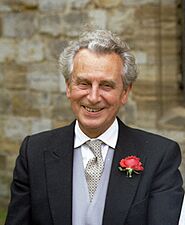

Many notable people have come from Suwałki over the years. They have made important contributions in science, politics, arts, and sports. Some of them include:
- Maria Andrejczyk (born 1996), a javelin thrower.
- Maria Konopnicka (1842–1910), a famous poet and writer.
- Alfred Kowalski (1849–1915), a painter.
- Henryk Minkiewicz (1880–1940), a general.
- Edward Szczepanik (1915–2005), an economist and the last Polish Prime Minister in Exile.
- Andrzej Wajda (1926–2016), a film director who won an Honorary Oscar.
- Pinchas Sapir (1906–1975), a Minister of Finance in Israel.
Suwałki's Sister Cities
Suwałki has friendly connections with other cities around the world. These are called twin towns or sister cities:
Images for kids
See Also
 In Spanish: Suwałki para niños
In Spanish: Suwałki para niños


